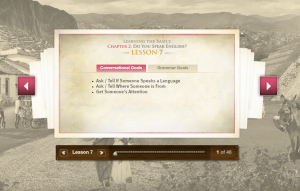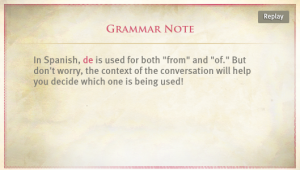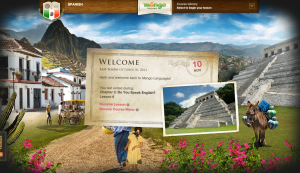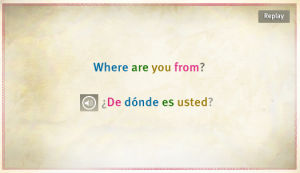For the past several months I have been actively searching for a good Spanish program for my family. So far we have been using Teach Them Spanish and really enjoying it. However, the kids are getting bigger now and the program is meant for little children (PreK-5th grade only) so this is not going to work for much longer, especially for my junior high student who is needing something more advanced and challenging. I was asking advice all over, questioning parents of high school kids whenever I came across one, and researching on the internet whenever I could. Then, one day I walked into the library and our librarian suggested something completely different… Mango Languages!
I had never heard of Mango Languages before, so I was a little hesitant to trust them. I asked around and it seemed none of my friends had heard of them either. I do know my librarian though and she is amazing. I figured it couldn’t hurt to give it a whirl, especially since it is free for all library members. How awesome is that?
Logging in to Mango Languages was very simple, coming straight from our library’s online resource center. Once logged in, we selected our language from a long list (about fifty) of choices. Here is where things got slightly tricky for me. Do I pick the Spain Spanish or the Latin American Spanish? I thought we should go with Spain Spanish, seeing as proper Castilian Spanish was wanted on the parental end. As it turns out Spain Spanish doesn’t have a full set of lessons quite yet, so we were forced to end our pursuit of that particular choice and move forward with Latin American instead.
 Other than that little snag, we are progressing nicely. The kids have been working on Latin American Spanish for two weeks now and are already on Chapter Two, Lesson Seven. To be truthful, I think they are having such an easy go of it because of the lessons we have been doing for the past several years in Teach Them Spanish. If it hadn’t been for that, my kids would still be doing well, just not zooming through it like they are now. Half of the words they are learning now, they have already been hearing.
Other than that little snag, we are progressing nicely. The kids have been working on Latin American Spanish for two weeks now and are already on Chapter Two, Lesson Seven. To be truthful, I think they are having such an easy go of it because of the lessons we have been doing for the past several years in Teach Them Spanish. If it hadn’t been for that, my kids would still be doing well, just not zooming through it like they are now. Half of the words they are learning now, they have already been hearing.
I think our previous exposure certainly was beneficial, but not necessary to use this program. Mango seems very thorough and starts off very simple. They make a point of using a lot of repetition, recognizing pronunciation, and (unlike other programs) they handle grammar conjugation. Mango makes a point of not only teaching you the words and what they mean, but (just as importantly) why you use a particular conjugation and when it should be used. This was big for me. I wanted our kids to have a thorough understanding of the language, not just a head knowledge for the right words to use.
Honestly, I notice no major differences between the Spain and Latin American choices, other than the pronunciation of certain words (Spain has slight lisps on various words). So time was not necessarily wasted by us having started on the Spain version, this just boosted their skills when having to begin anew with Latin American.
Some might be disappointed in the lack of pictures used in Mango, but I find this refreshing. My children can learn about the culture found in Spanish-speaking countries through various other means, for now I don’t want them distracted by images while focusing on the language. We can make cultural studies part of a supplemental program apart from the actual language. (Personally, my father-in-law is from Spain, Cullera; my mother-in-law from Mexico; and my father from Puerto Rico. This really isn’t a problem for us; I am only needing the language portion, the cultural is part of everyday life. For others, I could see how a supplemental cultural portion of their lessons might be necessary.)
 Overall, I am really liking this program. We have tested out Rosetta Stone and not really cared for it. We tested out a few others and found they weren’t what we were looking for either. So, until something else comes along which can top this program, Mango is what we are going to stick with. It is simple, thorough, cost-effective (hooray for free), and my kids are enjoying it. Who could ask for more?
Overall, I am really liking this program. We have tested out Rosetta Stone and not really cared for it. We tested out a few others and found they weren’t what we were looking for either. So, until something else comes along which can top this program, Mango is what we are going to stick with. It is simple, thorough, cost-effective (hooray for free), and my kids are enjoying it. Who could ask for more?
Which Spanish program are you using and what do you like about it the most?



Our live Spanish friend/teacher who comes twice weekly is our hands down best program. After that, we use a mix. I think it always changes for us because our kids are learning Spanish even before they learn to read. So that changes some of the programs that would work or when they would work well for the kids. Didn’t like Rosetta much either. My husband did.
LikeLike
What a great source to know about! Currently my son is taking a Russian class through Curr Click… excellent class! But we do have a toddler as well and it’s good to tuck these little bits of resources into a notebook for future use!!
LikeLike
We purchased the Rosetta Stone homeschool edition, but it is a little too advanced for my girls (ages 4 & 6). I’ve been looking for something that is a little more age appropriate and will check out Mango Languages. Thanks for the info.
LikeLike
If you are looking at the littles, as I call them, I would try using Teach Them Spanish. The PreK is lots of fun and will get the ball rolling with things they can use today, like colors and numbers.
LikeLike
I have used mango. It was ok, better than Rosetta Stone. And yes, FREE. They also have an app. Thanks for the reminder as children are asking to do Spanish with me again next semester I will definitely incorporate this into the mix.
LikeLike
Was there anything you didn’t like about Mango?
LikeLike
For me it was a little too basic, toppled with a big move and trying to get settled I just didn’t stick with it.
LikeLike
How far along did you get before stopping? I am curious to know if it increases in difficulty further along.
LikeLike
I don’t recall.
LikeLike
I know Spanish and incorporated it into our everyday life, but they hated that, most of them not being “worders” like me.
We tried Language Learnables and they found it too slow, and I found it might have been too “American” as in pronouncing unaccented vowels with a schwa, as in English. (La senorita is stuck on the end of a bun was their grasp of: La senorita esta comiendo el pan.) I was amazed at that, although a local ESL teacher told me it was really not bad, but she was inglesa.
I tried Alpha-Omega, and found it full of typos and other errors, too confusing because of editing mistakes. Not good.
At last, I found an ancient high school Spanish text and just taught them myself, as in a high school. They took two years and really do remember and know some Spanish that they sometimes are able to use on the job, now that they’re grown.
I, myself, do like the Rosetta, although I have never purchased it, but only viewed demos at fairs. However, for myself, it would be the most advanced levels and those I found excellent, but the beginning stuff was, again, flawed, needing editing.
Hope this helps. 🙂
LikeLike
Thanks for sharing!
LikeLike
Oh, meant to ask you: Do all libraries use the Mango thing? That is really interesting to me! 🙂
LikeLike
I’m not sure; a lot of libraries seem to, but I don’t have a complete list. Sorry!
LikeLike
Aw, don’t feel sorry! I just wondered. I think I’ll try to find it in the big city. I’m super glad to know it’s out there somewhere! 🙂
LikeLike
We are going to start Mango after the Christmas holidays with my 15 year old. I want to start with my little one when she turns 3. I teach part-time at a Montessori school and we use a program called Touch Spanish which I LOVE, but it is expensive!
LikeLike
I hope she enjoys this; my kids are zooming through nicely!
LikeLike
Reblogged this on RyanLeeWiley.
LikeLike
Hello,
Interesting post. If you’re looking for resources that will keep up with your kids growing up, we make language learning magazines for kids – in Spanish, French, German and English. They work alongside a range of online activities and resources that integrate speaking, listening, reading and writing. There are different issues for different ages and abilities, so you can keep up with your childrens progress. If you would like to see some examples, there are a number of free downloads and articles on our blog, plus advice from language teachers. This week we have some christmas themed activities! Please have a look
Thanks,
LikeLike